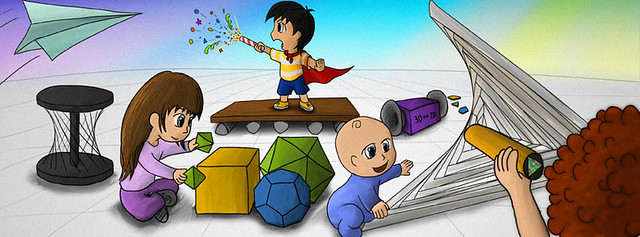Newsletter September 30, 2012

Welcome to adventurous math for the playground crowd! I am Moby Snoodles, and I love to hear from you at moby@moebiusnoodles.com
Moby’s mail
Thank you for offers to help review the book before it goes out! And for kind words, like these:
Anna Weltman of the Math Munch crew – a group of bloggers who will review together – writes: “I’m really excited, too! I’ve been looking forward to reading your book ever since I found out about it.”
Brendan Murphy, of “Philosophy without a home” offers: “I’d love to help doing reviews.” I also could not help but steal (with attribution) a part of his signature: “You do not study mathematics because it helps you build a bridge. You study mathematics because it is the poetry of the universe. Its beauty transcends mere things.” – Jonathan David Farley, NY Times letter.
We only have two chapters left to lay out and to illustrate. Then we’ll work with reviewers. I am very much looking forward to discussions with all you fabulous math lovers!
Book news
I have to confess I love fractals. This is a bit trivial, as confessions go. It is like saying, “I love music, food and holidays.” So does everyone else! Even people who don’t know the word “fractal” have seen, and liked, the ubiquitous pretty pictures.
However, not all of us (humans or whales) realize that much of the math behind fractals is very intuitive. It is the basis of traditional storytelling and the crafts of many tribes. It is also accessible to young kids, even toddlers!
Last week our illustrator, Ever, worked on the chapter about iconic fractals. He wanted to make a tree-type fractal, based on 3 “branches” and made out of creatures:
However, the number 3 is not typically associated with worms. We wanted our 3 to be more iconic, so we used an ant! Ant bodies consist of three major parts. If you want to know, they are called head, thorax (the “chest”) and gaster (the “stomach”).
But wait, there are two “branches” of the tree fractal on the ant’s gaster and none on the head! The ant does have three parts, but they are not used, one-for-one, in the structure of the fractal! The artistic reason was the smallness of the head, which is correct anatomically. And the artistic solution was to “cartoon” the ant, making its head large. I think it’s cute. It also expresses the math we need.
This is the sort of conversation I often have with three- to six-year-old kids. They use stamps or stickers or their own hands to make fractals. What number goes with what image? Where do you “branch” your fractal? How do you keep the pattern? What sizes do you choose for different parts?
Fascinating! The same ideas and thoughts come up in the work of little ones and of grown-ups! These must be deep and lovable ideas. Like music, food and holidays.
Talk to you again on October 15th!
Moby Snoodles, aka Dr. Maria Droujkova
Related Posts
Posted in Newsletter







Leave a Reply